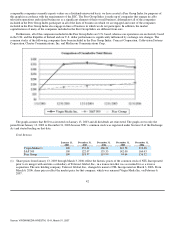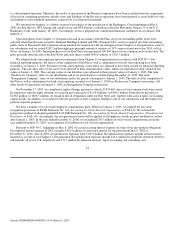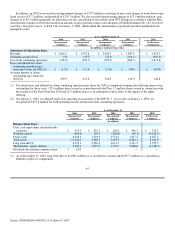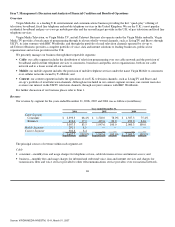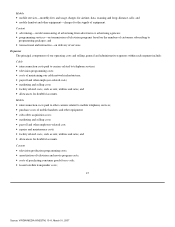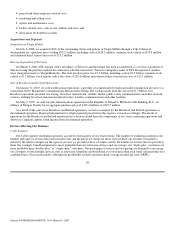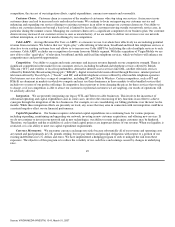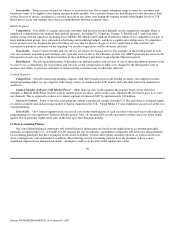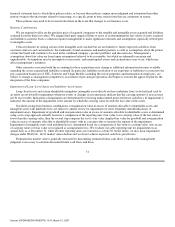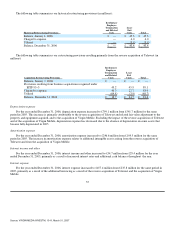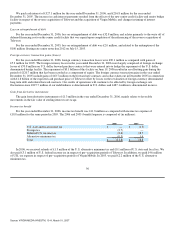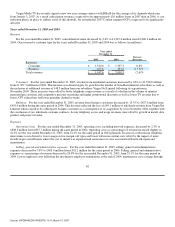Virgin Media 2006 Annual Report Download - page 56
Download and view the complete annual report
Please find page 56 of the 2006 Virgin Media annual report below. You can navigate through the pages in the report by either clicking on the pages listed below, or by using the keyword search tool below to find specific information within the annual report.
estimates include inherent uncertainties, including those relating to the timing and amount of future cash flows and the discount rate
used in the calculation. Assumptions used in these cash flows are consistent with our internal forecasts. If actual results differ from the
assumptions used in the impairment review, we may incur additional impairment charges in the future.
Income Taxes
Our provision for income taxes is based on our current period income, changes in deferred income tax assets and liabilities,
income tax rates, and tax planning opportunities available in the jurisdictions in which we operate. From time to time, we engage in
transactions in which the tax consequences may be subject to some uncertainty. Examples of such transactions include business
acquisitions and disposals, issues related to consideration paid or received in connection with acquisitions, and certain financing
transactions. Significant judgment is required in assessing and estimating the tax consequences of these transactions. We prepare and
file tax returns based on our interpretation of tax laws and regulations and record estimates based on these judgments and
interpretations.
At each period end, it is necessary for us to make certain estimates and assumptions to compute the provision for income taxes
including, but not limited to the expected operating income (or loss) for the year, projections of the proportion of income (or loss)
earned and taxed in the United Kingdom and the extent to which this income (or loss) may also be taxed in the United States,
permanent and temporary differences, the likelihood of deferred tax assets being recovered and the outcome of contingent tax risks. In
the normal course of business, our tax returns are subject to examination by various taxing authorities. Such examinations may result
in future tax and interest assessments by these taxing authorities for uncertain tax positions taken in respect to matters such as business
acquisitions and disposals and certain financing transactions including intercompany transactions, amongst others, and we accrue a
liability when we believe an assessment may be probable and the amount is estimable. In accordance with generally accepted
accounting principles, the impact of revisions to these estimates are recorded as income tax expense or benefit in the period in which
they become known. Accordingly, the accounting estimates used to compute the provision for income taxes have and will change as
new events occur, as more experience is acquired, as additional information is obtained and our tax environment changes.
Fixed Assets
Labor and overhead costs directly related to the construction and installation of fixed assets, including payroll and related costs of
some employees and related rent and other occupancy costs, are capitalized. The payroll and related costs of some employees that are
directly related to construction and installation activities are capitalized based on specific time devoted to these activities where
identifiable. In cases where the time devoted to these activities is not specifically identifiable, we capitalize costs based upon
estimated allocations. Costs associated with initial customer installations are capitalized. The costs of reconnecting the same service to
a previously installed premise are charged to expense in the period incurred. Costs for repairs and maintenance are charged to expense
as incurred.
We assign fixed assets and intangible assets useful lives that impact the annual depreciation and amortization expense. The
assignment of useful lives involves significant judgments and the use of estimates. Our managers use their experience and expertise in
applying judgments about appropriate estimates. Changes in technology or changes in intended use of these assets may cause the
estimated useful life to change, resulting in higher or lower depreciation charges or asset impairment charges.
Restructuring Costs
As of January 1, 2003, we adopted FASB Statement No. 146, Accounting for Costs Associated with Exit or Disposal Activities, or
FAS 146, and recognize a liability for costs associated with restructuring activities
52
Source: VIRGIN MEDIA INVESTM, 10−K, March 01, 2007


